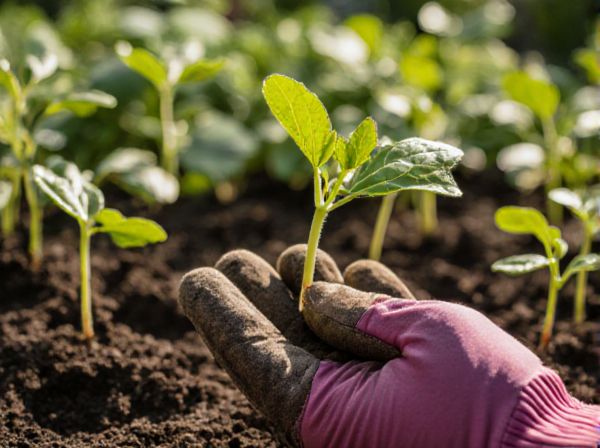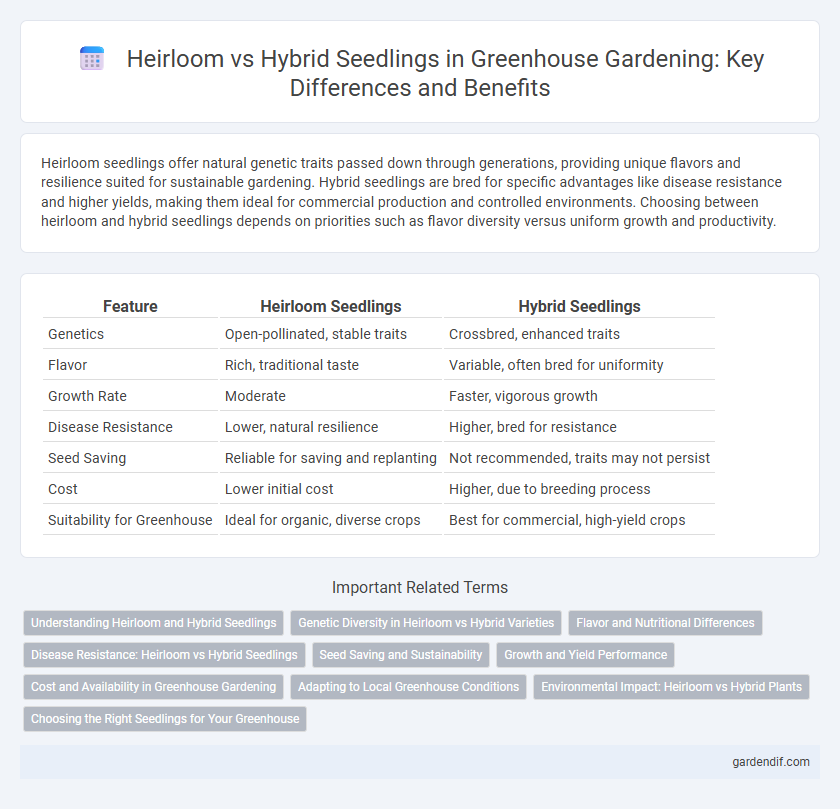
Heirloom Seedlings vs Hybrid Seedlings Illustration
Heirloom seedlings offer natural genetic traits passed down through generations, providing unique flavors and resilience suited for sustainable gardening. Hybrid seedlings are bred for specific advantages like disease resistance and higher yields, making them ideal for commercial production and controlled environments. Choosing between heirloom and hybrid seedlings depends on priorities such as flavor diversity versus uniform growth and productivity.
Table of Comparison
| Feature | Heirloom Seedlings | Hybrid Seedlings |
|---|---|---|
| Genetics | Open-pollinated, stable traits | Crossbred, enhanced traits |
| Flavor | Rich, traditional taste | Variable, often bred for uniformity |
| Growth Rate | Moderate | Faster, vigorous growth |
| Disease Resistance | Lower, natural resilience | Higher, bred for resistance |
| Seed Saving | Reliable for saving and replanting | Not recommended, traits may not persist |
| Cost | Lower initial cost | Higher, due to breeding process |
| Suitability for Greenhouse | Ideal for organic, diverse crops | Best for commercial, high-yield crops |
Understanding Heirloom and Hybrid Seedlings
Heirloom seedlings are grown from seeds passed down through generations, maintaining genetic stability and unique flavors ideal for traditional gardening and seed saving. Hybrid seedlings result from crossbreeding two different plant varieties to enhance traits like disease resistance, higher yield, and uniform growth. Understanding the differences helps gardeners choose between heirlooms for diversity and hybrids for performance in greenhouse cultivation.
Genetic Diversity in Heirloom vs Hybrid Varieties
Heirloom seedlings preserve genetic diversity by maintaining open-pollinated traits passed down through generations, resulting in unique plant characteristics and resilience. Hybrid seedlings, created through controlled crossbreeding, offer uniformity and vigor but often lack the broad genetic variability found in heirloom varieties. This reduced genetic diversity in hybrids can limit adaptability to changing environmental conditions and increase susceptibility to pests and diseases.
Flavor and Nutritional Differences
Heirloom seedlings preserve genetic diversity, offering richer, more complex flavors and higher concentrations of vitamins, antioxidants, and minerals compared to hybrid seedlings. Hybrid seedlings are bred for traits like uniformity, pest resistance, and higher yield, sometimes compromising taste and nutritional content. Choosing heirloom varieties enhances greenhouse produce quality by delivering superior flavor profiles and nutritional benefits.
Disease Resistance: Heirloom vs Hybrid Seedlings
Heirloom seedlings typically exhibit lower disease resistance due to their genetic diversity and traditional breeding methods, making them more susceptible to common greenhouse diseases. Hybrid seedlings are often bred specifically for enhanced disease resistance, combining desirable traits from multiple parent plants to improve survivability and reduce the need for chemical treatments. Greenhouse growers prefer hybrids for consistent resilience against fungal infections, bacterial wilt, and viral pathogens, optimizing crop yield and quality.
Seed Saving and Sustainability
Heirloom seedlings provide the advantage of seed saving, allowing gardeners to harvest and replant seeds year after year, promoting genetic diversity and sustainability in greenhouse cultivation. Hybrid seedlings, while offering improved vigor and disease resistance, generally do not produce viable seeds, limiting opportunities for seed saving and reducing long-term sustainability. Prioritizing heirloom varieties in greenhouses supports ecological balance and preserves plant heritage through continuous, self-sustaining seed cycles.
Growth and Yield Performance
Heirloom seedlings typically grow slower but develop complex flavors and maintain genetic diversity, appealing to gardeners valuing tradition and quality. Hybrid seedlings exhibit faster growth rates and higher yield performance due to selective breeding, making them ideal for commercial greenhouse production focused on maximizing output. Choosing between heirloom and hybrid seedlings depends on prioritizing either unique plant characteristics or accelerated growth and productivity.
Cost and Availability in Greenhouse Gardening
Heirloom seedlings typically cost more due to their open-pollinated nature and limited availability but offer unique, stable plant varieties ideal for greenhouse gardening. Hybrid seedlings are generally less expensive and widely available, providing higher yields and disease resistance, making them a cost-effective choice for large-scale greenhouse operations. Greenhouse gardeners must balance budget constraints with the desire for specific plant traits when selecting between heirloom and hybrid seedlings.
Adapting to Local Greenhouse Conditions
Heirloom seedlings, prized for their genetic stability, adapt steadily to specific local greenhouse microclimates, offering consistent traits generation after generation. Hybrid seedlings, engineered for vigor and disease resistance, often thrive more aggressively in controlled environments but may require precise temperature, humidity, and light settings to maximize yield. Selecting between heirloom and hybrid seedlings depends on how closely the greenhouse conditions mimic the plants' native environment, influencing growth performance and overall crop success.
Environmental Impact: Heirloom vs Hybrid Plants
Heirloom seedlings, grown from open-pollinated seeds, promote biodiversity and support sustainable gardening by preserving genetic diversity and reducing dependency on chemical inputs. Hybrid seedlings often require more intensive agricultural practices, including higher water use and pesticide applications, leading to increased environmental impact. Choosing heirloom plants can mitigate ecological harm by fostering resilient ecosystems and conserving traditional plant varieties.
Choosing the Right Seedlings for Your Greenhouse
Heirloom seedlings offer genetic diversity and unique flavors, making them ideal for gardeners seeking traditional varieties and preserving plant heritage in their greenhouse. Hybrid seedlings provide enhanced disease resistance, higher yields, and uniform growth, suitable for maximizing productivity and ensuring consistent results under controlled greenhouse conditions. Selecting the right seedlings depends on balancing the desire for biodiversity and flavor with the need for robust, high-performing plants tailored to your specific greenhouse environment.
Heirloom Seedlings vs Hybrid Seedlings Infographic

 gardendif.com
gardendif.com